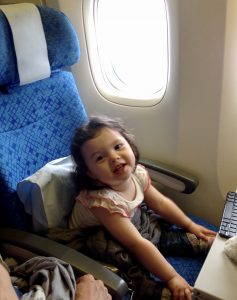
Flying with small children
So you’ve planned the perfect holiday, rented a gorgeous villa, decided on the perfect itinerary… and then it hits you- you’re going to have to do a 14 hour flight with your toddler.
Don’t panic- here are some tips to get you through the first hurdle of your vacation, and hopefully get you to your destination in a fit state to enjoy it.
1. Do not consider sedating your child
I know- everyone has told you to just give Benadryl/ some other sedating antihistamine and your life will be peachy. Please do not do it.
Firstly, around 15% of children will have a paradoxical reaction to the antihistamine; in other words, instead of having the sleeping angel you hope for, you may end up with a screaming virago scaling the walls of the cabin for the next 12 hours (believe me- I’ve been called to see them on long haul flights before!).
Secondly, there is good evidence that a sedating antihistamine may just be dangerous for your child. There is well-documented evidence that children under the age of 8 years drop their oxygen levels slightly around 6 hours into long haul flights. If you sedate them further, you run the risk of further dropping their oxygen levels (especially when you consider their anatomy: big head, short neck and floppy larynx), which can potentially be a problem for the developing brain.
2. Do use some homeopathic remedies instead
Use lavender essential oils sprinkled either on your child’s clothing or on a muslin cloth so that your child breathes in the scent. Lavender has long been associated with soothing and calming young children, and there are no risks or unwanted side effects associated with its use.
Give your child chamomile tea. Take some chamomile teabags on the flight with you and ask the stewards to help you make it. Remember to either add cool water or allow it to cool to room temperature. Allow your child to drink it throughout the flight.
3. Try to book a night flight if at all possible
It really helps to be able to sleep for most of the flight! As a multi-cultural, cross-continental family, we’ve done our fair share of long haul flights with our three children at all ages. The ideal long haul flight is one that leaves your home at nighttime (around or after your child’s bedtime) and arrives at your destination in the morning ready for you to start your day.
Consider what your child will wear to fly. For a night flight, we take our children to the airport wearing their pyjamas- they think this is lots of fun, and it helps us to quickly settle them down to “bed” once we’re on board. We then pack day clothes to change into just before we arrive at our destination.
4. If flying during the day, pack plenty of age-appropriate activities
Depending on the age of your child, pack some favourite toys or games (don’t pick anything with many small parts which may get lost on the flight, causing lots of tears). Then pack a few “surprise” items: depending on the age of the child, these can be new books, sticker books, colouring books, activity books (there are books designed for toddlers with zips, buttons, velcro and snap fasteners to explore).
If you have a lot of layovers planned, and your child is at an age when they are starting to watch some television, consider downloading a few of their favourite programmes onto a tablet. Young children are unlikely to tolerate wearing headphones, and are also more comfortable watching familiar programmes (often ones they have watched 20 times previously!).
5. Remember to get your child to suck either some liquid or a sweet on the way up and down
If your child is still nursing or taking a bottle of milk, try to time their milk feeds so that they are ready for a feed at the time of take off and landing. An older child can suck a sweet or candy if preferred.
The act of sucking helps to reduce the pressure in the middle ear that leads to that painful “popping” sensation in the ears when the aircraft takes off and lands.
It is always worth travelling with some basic medical supplies in your hand luggage. These days, with restrictions on carrying fluids, it isn’t practical to take a bottle of paracetamol syrup on board, but certain countries sell paracetamol in sachets which are very handy. Alternatively, you can prefill a syringe of the correct dose of paracetamol syrup and carry it in a plastic box in your hand luggage.
What tips and tricks have you found helps your child? Feel free to leave a comment below.
I will cover tips and tricks for beating jet lag in a future post. Happy travels 😊

Leave A Reply